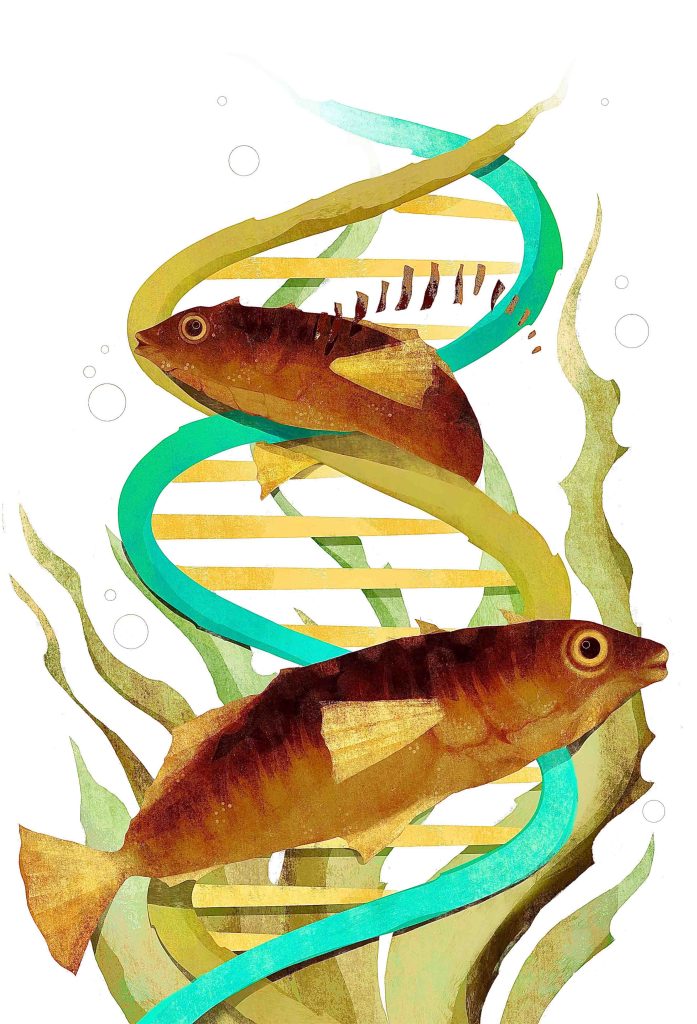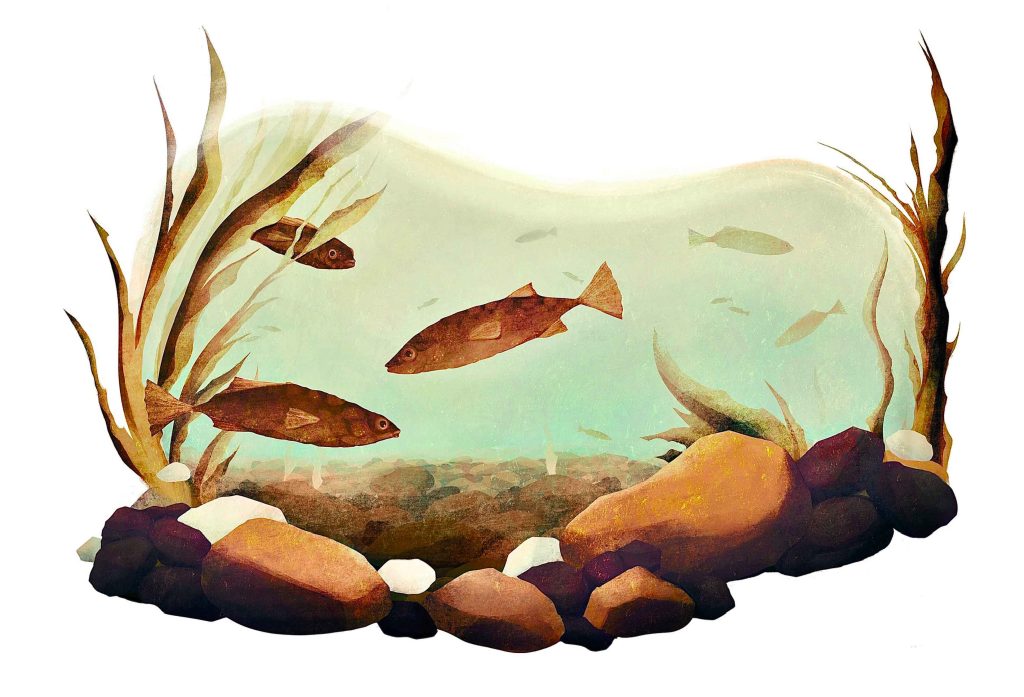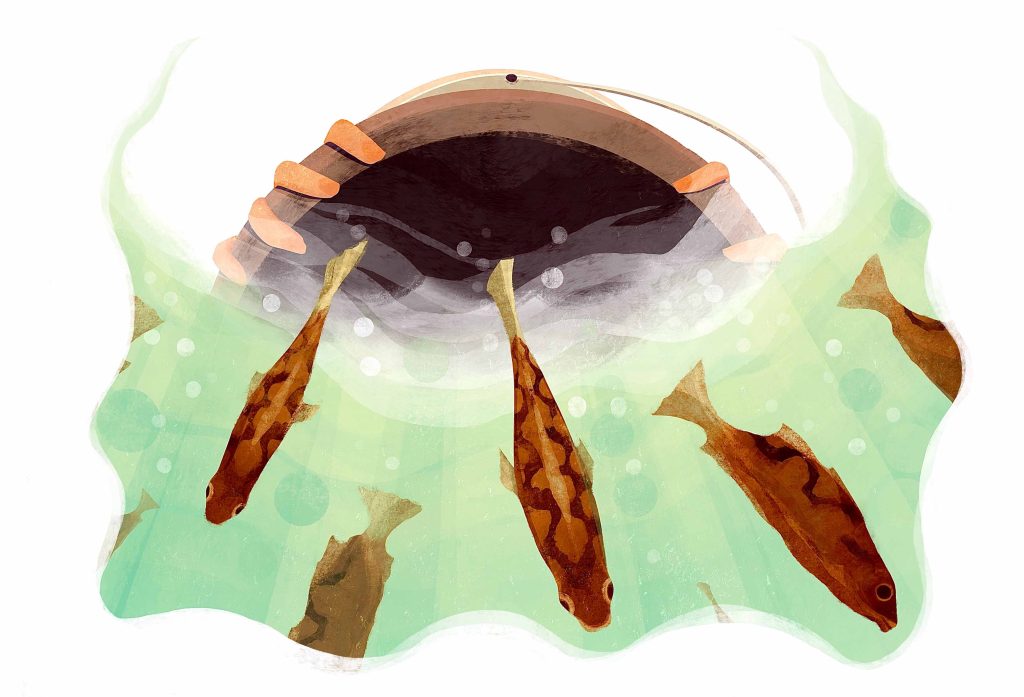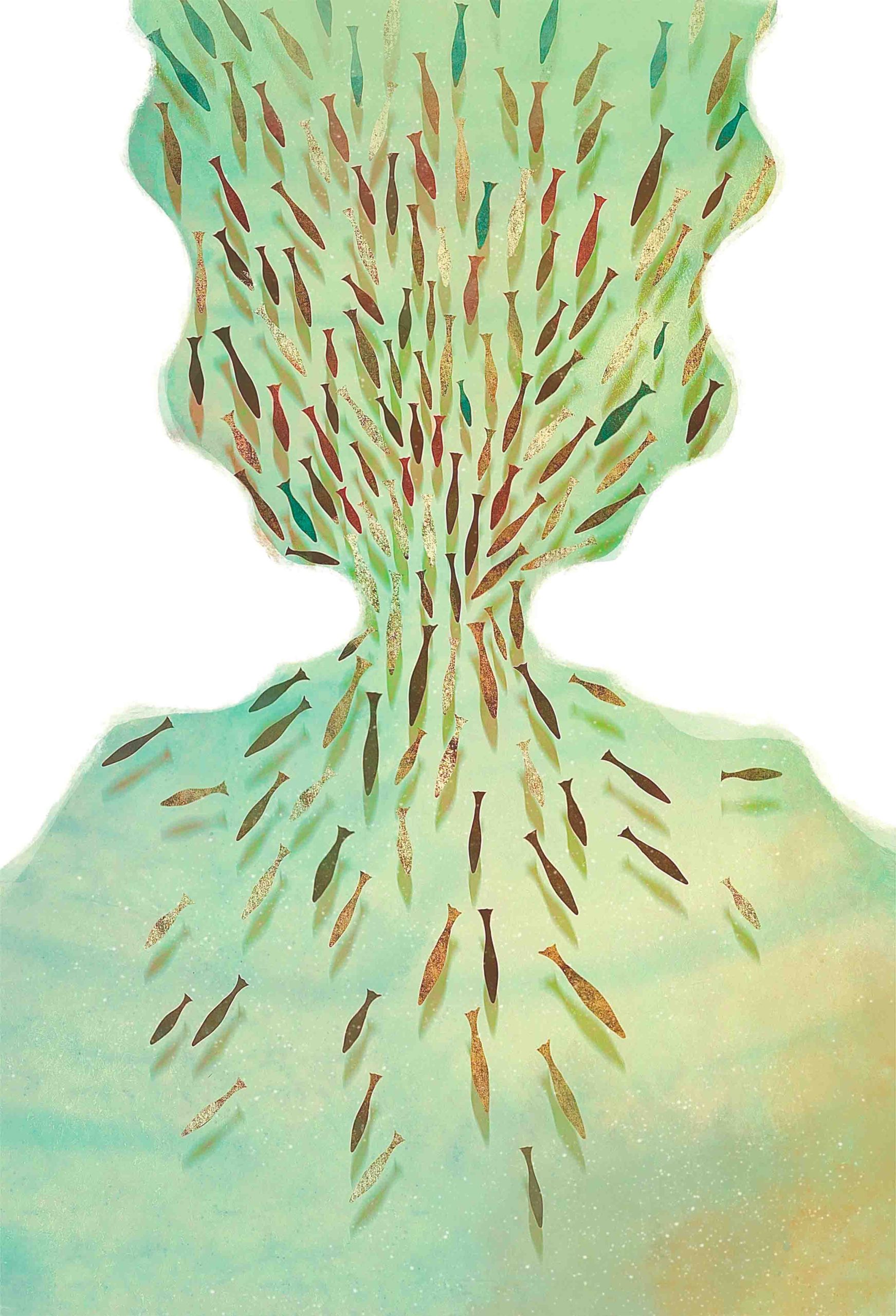Restoration is defined as the return of an ecosystem to its condition prior to disturbance or degradation. But is restoration ever truly possible? Environmental conditions are constantly changing. So what happens to established ecosystems when a species is suddenly reintroduced?
Watershed restoration projects often occur in waterways that have experienced physical, chemical, and morphological changes caused by human activity. Dams, water diversions, pollution, and run-off can significantly transform ecosystems by impacting the species that can survive and thrive in new and changing conditions.
Across southern California, restoration initiatives have targeted the reintroduction of top predators such as trout or salmon to restore ecosystems to their historic conditions. While transplanting fish increases biodiversity, it can cause detrimental effects on existing species that have adapted and evolved to a habitat free of predators. Conservation efforts must recognise current ecosystem dynamics to holistically address the biodiversity and evolutionary impacts of human interference.
Evolutionary background
Consider the three-spined stickleback fish. This small freshwater species is found in inland and coastal waterways across southern California and the rest of North America. About 20,000 years ago, ancestral sticklebacks migrated from oceanic to freshwater habitats, mostly occupying lakes, rivers, and streams. This massive environmental shift meant that different populations of sticklebacks now faced new and different predators. While some populations retained a large pelvic fin and protective armour, sticklebacks in freshwater environments with few predators evolved to lose their armour over the course of several generations.
Today, there are 16 recognised and distinct species of sticklebacks globally, two of which are distinct threespined stickleback species. These species have demonstrated physical adaptations rapidly across evolutionary timescales. Due to environmental shifts, resource availability and the presence of predators, three-spined sticklebacks have repeatedly colonised freshwater and oceanic habitats throughout history. As a result, they have expressed evolutionary changes in as few as ten generations.
The movement of the species between oceanic and freshwater environments appears to have made the species uniquely resilient to changing environments and unforeseen threats. The rapid evolution of three-spined sticklebacks has made the species a common subject for studies related to natural selection, especially because modern human-caused disturbances, such as commercial and industrial activity, dam construction and watershed pollution, have influenced such evolutionary processes.

Modern pressures
Habitat alteration can influence evolution and adaptation through the separation of populations which may lead to different environmental conditions, predators, and other threats. Humans have contributed to the evolution of three-spined sticklebacks through the construction of dams and other forms of habitat degradation that separated the fish from their historic predators. Subsequently, many three-spined stickleback populations adapted to rivers without the necessity of anti-predator armour or behaviours.
Barriers such as dams reduce the connectivity of populations by restricting movement. This isolation inhibits breeding opportunities between populations and impacts the genetic diversity of a population. Genetic diversity is important for survival and reproduction, allowing species to adapt to potential environmental changes. Limited breeding opportunities can lead to inbreeding, which decreases population resilience against environmental threats.
In highly industrialised areas, human alterations to water quality can include increased salinity or temperature due to run-off or drainage. While these changes can be detrimental to marine species, some have evolved to accommodate such pressures. For example, juvenile three-spined sticklebacks have displayed tolerance to the introduction of warm and salty water to freshwater habitats, exhibiting faster growth and lower parasite burdens than those in undisturbed freshwater habitats. The uninhibited growth of juveniles in altered environments illustrates the ways in which the evolutionary history of sticklebacks allows for movement between oceanic and freshwater environments with minimal detrimental effects.
Conservation implications
Rapid adaptation does not mean that three-spined sticklebacks are invulnerable to environmental changes. Although they have demonstrated the ability to adapt to a changing environment, populations may suffer in the long term if adaptive benefits are not uniform across all life stages. Threats or stressors may vary from one generation to the next. So, a beneficial adaptation can quickly become a hindrance in the event that environmental conditions change again. Three-spined stickleback populations seem incredibly resilient in the face of human pressures due to learned and evolved behaviours. However, a lasting ecological consequence of environmental disturbance is increased population vulnerability, particularly when restoration efforts occur without addressing recent environmental adaptations.
For example, if three-spined sticklebacks are reintroduced to a restored environment for which they are no longer adapted, or if non-native species are introduced into their range, stickleback populations may be negatively impacted. Populations may be vulnerable to new predators, environmental threats, lack of adequate habitats or nutrients, or newly introduced bacteria and diseases. The acknowledgment of the perceived resilience of the three-spined stickleback must be met with the understanding that the species is not immune to population decline. Three-spined stickleback fish have demonstrated the potential for rapid evolution throughout history. Nevertheless, the compounded effects of environmental destruction and disturbance pose a threat to the resilience of freshwater fish populations. It is also important to recognise that environmental changes caused by human activity occur much more quickly than natural species migrations or physical environmental shifts.
The migration of three-spined sticklebacks from oceanic to freshwater environments resulted in the loss of their protective armour, hind fins, and anti-predator behaviour because of reduced predation in lakes and streams, typically attributed to overfishing of predators or dam construction that separated species. However, predatory fish have been reintroduced to some fresh water environments to diversify riverine ecosystems.
The reintroduction of predators can lead to “reversed selection” in the three-spined stickleback, where the fish responds to changing environmental conditions with an increase or decrease in armoured plates within just a few decades. They have been observed to exhibit forms of more or less armour, some even resembling previous generations, in response to changes to their ecosystems and predators. Therefore, the reintroduction of predators into lakes and streams to increase biodiversity can have inadvertent evolutionary impacts on existing populations. In the same way that three-spined sticklebacks may experience adverse impacts due to the introduction of non-native species, the reintroduction of predators can present sudden and significant pressures on an ecosystem in which species have already adapted to the absence of predators.
Stocking predators in rivers full of unarmored sticklebacks can result in a ‘genetic bottleneck’—an event that significantly reduces the population size of a species, resulting in limited genetic diversity. Human disturbances such as agricultural activity, run-off, oxygen consumption, or pollution can also cause genetic bottlenecks. Populations of three-spined sticklebacks in polluted freshwater environments have experienced bottlenecks, inbreeding, and reduced genetic diversity. A lack of interbreeding and genetic mixing creates the potential for isolation that reduces a population’s resistance to certain pressures. Bottleneck events can be catastrophic for marine populations when low genetic diversity results in mass vulnerability to diseases.

Conservation in context: Case studies from California
In 2015, three-spined sticklebacks were reintroduced to Mountain Lake in Presidio, California, by transplanting the fish from a single nearby population. The three-spined stickleback is the only fish species native to Mountain Lake, but the introduction of predatory fish throughout the 20th century led to dwindling populations and unprecedented habitat loss. This reintroduction effort was an element of a larger holistic strategy to restore and enhance fish populations in the lake, hinging on the role of the three-spined stickleback as a critical host species for California floater mussels.
However, in 2020, nearly all of the reintroduced population died due to exposure to disease. The deaths were associated with low genetic diversity caused by bottleneck due to translocation. In response to this die-off, a second reintroduction has been planned with the inclusion of sticklebacks from multiple nearby populations with the hopes that increased genetic diversity will improve the population’s resistance to disease and other threats. Therefore, although genetic isolation and bottleneck events do not necessarily have a significant impact on reproduction, a lack of genetic diversity can leave populations vulnerable to calamitous circumstances.
Beyond genetic diversity considerations, hydrological conditions are a critical element of a comprehensive strategy in reintroduction efforts. In 2014, for example, several populations of three-spined sticklebacks were translocated within California from the Santa Clara River to the Santa Francisquito Creek due to extreme drought conditions that diminished available habitat. Translocation efforts identified sites in the creek with reliable water flows and compatible habitats, and fish were gradually acclimated to the new release waters prior to translocation. However, even after rescue efforts, prolonged extreme drought caused vast portions of the Santa Clara River to become uninhabitable for the three-spined stickleback. Monitoring efforts continued in the years following release, but drought, debris build-up in the creek and complex hydrological and morphological features have resulted in minimal observations of three-spined stickleback populations. In many cases, populations were unable to migrate or recover from unforgiving drought conditions.
In the context of reintroduction and restoration, the preservation of genetic diversity and healthy populations must be considered in relation to their evolutionary potential. Further, the physical conditions of the reintroduction site—including the presence of other species, hydrological conditions, and climatic hazards—greatly influence the health and mortality rates of the reintroduced species. Despite the astounding rapid changes that can occur among three-spined sticklebacks, predator introduction and species translocation present a sudden and considerable threat. Populations may be able to adapt over time, but they may not be able to recover.

Conservation considerations
How, then, can we restore ecosystems without causing catastrophic damage to existing populations? Conservation efforts and watershed management ought to consider the genetic diversity and evolutionary patterns of resident species, such as the three-spined stickleback, before causing physical alterations to a riverine habitat or reintroducing native predators to an environment. They must also consider how an environment has changed over time, how resident species have adapted to current conditions, whether current populations can handle sudden environmental shifts or an influx of predators, how human interference may support biodiversity, and the evolutionary implications of human interference.
Reintroduction is dependent on numerous variables within a particular environmental context. Differences in water quality and chemical composition, the presence of dams or non-native predator species, and the regional climatic conditions that present environmental hazards, for example, can dictate the health and productivity of reintroduced species. These variables may change depending on context—human-imposed habitat fragmentation via barriers often occurs along rivers, while the introduction of non-native species is commonplace in lakes. While the three-spined stickleback may be native to waters across the world, its ability to survive under particular conditions and stressors is dependent on a holistic approach to reintroduction that maintains a balanced ecosystem.
Connectivity is an increasingly prevalent topic in conservation, particularly in the context of urban rivers and streams where water pollution and habitat fragmentation lead to cascading impacts on watershed ecosystems. In the case of three-spined sticklebacks, changes in connectivity have led to rapid and measurable adaptations that can lead to population vulnerability. By incorporating predator-prey dynamics and long-term monitoring of ecosystem restoration planning efforts, conservation managers and practitioners can preserve biodiversity without causing cascading environmental impacts to populations and food webs that have adapted to a predator-free environment.
Further Reading
Begum, M., V. Nolan, and A. D. C. MacColl. 2023. Ecological constraint, rather than opportunity, promotes adaptive radiation in three-spined stickleback (Gasterosteus aculeatus) on North Uist. Ecology and evolution 13(1): e9716. https://doi.org/10.1002/ece3.9716.
Santos, E. M., P. B. Hamilton, T. S. Coe, J. S. Ball, A. C. Cook, I. Katsiadaki and C. R. Tyler. 2013. Population bottlenecks, genetic diversity and breeding ability of the three-spined stickleback (Gasterosteus aculeatus) from three polluted English Rivers. Aquatic toxicology 142-143: 264-271. https://doi.org/10.1016/j.aquatox.2013.08.008.
Lavelle, A. M., M. A. Chadwick, D. D. A. Chadwick, E. G. Pritchard and N. R. Bury. Effects of habitat restoration on fish communities in urban streams. Water 13(16): 2170. https://doi.org/10.3390/w13162170.
Originally published on 13 May 2024






